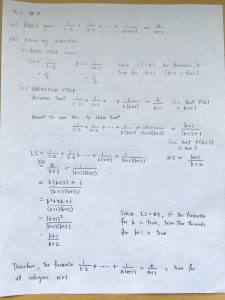2)
a) Determine whether f is invertible. If f is invertible, find it’s inverse f^-1. Explain your answer.
f(x) = 2x+1 is one-to-one
f^-1(x) = (x-1)/2
check:
(f^-1 o f)(x) = (2x + 1 – 1) / 2
= 2x/2
= x
(f o f^-1)(x) = 2 ((x-1)/2) + 1
= x – 1 + 1
= x
If f: f -> f^-1 is one-to-one, it is invertible. It’s inverse f^-1 is the function f^-1:f^-1 o f such that f -> f^-1 o f -> f^1 and f^-1 -> f o f^-1 -> f are identify functions.




Recent Comments